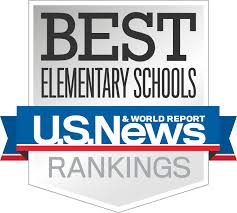Best Tennessee Schools
U.S. News analyzed 105,093 pre-K, elementary and middle schools. Browse our district and school profiles to find the right fit for you.
Editor’s Note: As an alum of Thurman Francis School, I was thrilled to see Thurman Francis Magnet School—as well as Central Magnet and McFadden School of Excellence—top the list in the recent 2024 U.S. News & World Report rankings. Rutherford County continues to shine with top schools like McFadden School of Excellence, ranked 1st for elementary schools, and Central Magnet School, ranked 1st for middle and high schools. McFadden serves 389 students, while Central Magnet has 1,210 students and boasts a Level 5 status for exceptional growth. Thurman Francis Arts Academy ranks 4th for elementary and 2nd for middle schools, with a focus on arts and 657 students enrolled. Our district has a graduation rate of 97.2%, reflecting strong academic performance and community support, making Rutherford County a top choice for families seeking quality education.
If your child has had the opportunity to attend a magnet school—like our oldest son—count yourself very blessed. Some argue that public magnet schools often favor academically strong students through selective admissions, which can discriminate against those who struggle. By prioritizing grades and test scores, these schools may exclude capable learners with valuable skills who don’t excel in traditional assessments. This creates an environment that views only certain students as “worthy,” perpetuating inequalities and limiting diversity.
Felicia and I now have two new grand-babies. My hope is that they both will have the ‘opportunity’ to attend Thurman Francis Magnet School like their father did. Please let me know your thoughts and suggestions on how we reach those students who often struggle to perform academically and often fall behind. My email is MikeSparksTn@gmail.com.
___________________________________________________________________________
How U.S. News Calculated the 2025 Best Elementary and Middle Schools Rankings
State assessment data determines how most elementary and middle schools fare in these rankings.
Great elementary and middle schools educate their students from all socioeconomic backgrounds with the goal of setting them up for success. In turn, students develop the core competencies in state curricula that best prepare them for high school.
U.S. News’ updated rankings of public elementary and middle schools can help you determine the best local schools for your children.
- Mcfadden School of Excellence in Murfreesboro: serves kindergarten through fifth grade; has 389 students.
- Merrol Hyde Magnet School in Hendersonville: serves kindergarten through twelfth grade; has 668 students.
- Discovery School in Murfreesboro: serves pre-kindergarten through sixth grade; has 389 students.
- Thurman Francis Arts Academy/Magnet School for the Arts in Smyrna: serves kindergarten through eighth grade; has 657 students.
- Lockeland Elementary in Nashville: serves kindergarten through fifth grade; has 314 students.
- Clovercroft Elementary School in Franklin: serves kindergarten through fifth grade; has 690 students.
- Jordan Elementary School in Brentwood: serves pre-kindergarten through fifth grade; has 611 students.
- Lookout Mountain Elementary in Lookout Mountain: serves kindergarten through fifth grade; has 586 students.
- Thrasher Elementary in Signal Mountain: serves kindergarten through fifth grade; has 389 students.
- Nolan Elementary in Signal Mountain: serves kindergarten through fifth grade; has 732 students.
- Campus School in Memphis: serves kindergarten through fifth grade; has 398 students.
- Julia Green Elementary in Nashville: serves kindergarten through fourth grade; has 432 students.
- Grassland Elementary in Brentwood: serves kindergarten through fifth grade; has 501 students.
- Crosswind Elementary School in Collierville: serves kindergarten through fifth grade; has 701 students.
- Crockett Elementary in Brentwood: serves pre-kindergarten through fifth grade; has 704 students.

Best middle schools in Tennessee 2024
Here are the 15 best middle schools in Tennessee, according to U.S. News & World Report’s ranking.
- Central Magnet School in Murfreesboro: serves sixth through twelfth grade; has 1,210 students.
- Thurman Francis Arts Academy/Magnet School for the Arts in Smyrna: serves kindergarten through eighth grade; has 657 students.
- Merrol Hyde Magnet School in Hendersonville: serves kindergarten through twelfth grade; has 668 students.
- Meigs Middle in Nashville: serves fifth through eighth grade; has 695 students.
- Martin Luther King Junior School in Nashville: serves seventh through twelfth grade; has 1,211 students.
- Brentwood Middle School in Brentwood; serves sixth through eighth grade; has 1,127 students.
- Sunset Middle School in Brentwood: serves sixth through eighth grade; has 655 students.
- Fred J Page Middle School in Franklin: serves sixth through eighth grade; has 1,249 students.
- Woodland Middle School in Brentwood: serves sixth through eighth grade; has 957 students.
- T.W. Hunter Middle School in Hendersonville: serves sixth through eighth grade; has 551 students.
- Chattanooga School for the Liberal Arts in Chattanooga: serves kindergarten through twelfth grade; has 792 students.
- Maxine Smith Steam Academy in Memphis: serves sixth through eighth grade; has 364 students.
- University School in Johnson City: serves kindergarten through twelfth grade; has 597 students.
- Mill Creek Middle School in Nolensville: serves sixth through eighth grade; has 900 students.
- Chatt High Center for Creative Arts in Chattanooga: serves sixth through twelfth grade; has 649 students.
The rankings use the same methodology for all included grade levels. For each state, schools were assessed on their shares of students who were proficient or above proficient in their mathematics and reading/language arts state assessments. Half of the formula assessed the scores themselves and the other half incorporated the test results in the context of socioeconomic demographics. In other words, the top-ranked schools are all high-achieving and have succeeded at educating all their students.
There is no national ranking – but there are distinct elementary and middle school rankings calculated at the state and district levels, as well as state rankings specific to charter schools.
U.S. News summed each school’s standardized scores on the four ranking indicators. From these, a single zero to 100 overall score was computed for each school, representing how well each school ranked within its state on a percentile basis. For example, a school with a score of 55.00 performed in the 55th percentile among all schools in its ranking, meaning 45% of the schools performed better than, and 55% of the schools didn’t perform as well as, that school.
Ranks were assigned in descending order of overall scores. Schools below the 25th percentile have their scores concealed and display the entire bottom quartile’s ranking range. Those unranked were all public schools that either served special subgroups, had fewer than 20 students enrolled in the federal government dataset, had fewer than 30 test-takers in reading/language arts and math, or for which usable state assessment data could not be obtained. This means all private kindergarten through 12th grade schools on our website are unranked since they do not have state assessment data.
U.S. News’ K-12 directory lists 119,272 schools, including 96,982 public schools and 22,290 private schools. Among the 79,374 public schools with elementary and/or middle school grades, 65,759 (83%) were ranked in either the elementary or middle schools ranking. These include 5,675 schools ranked in both.
In total, 47,573 elementary schools and 23,861 middle schools were ranked. When combined with the 17,656 public high schools U.S. News ranked in 2024, U.S. News has assigned 89,090 state ranks across its elementary, middle and high schools rankings.
Ranking Indicators
Each state administers standardized tests measuring student proficiency in subjects related to mathematics and reading/language arts. The states and localities look closely at students’ performance on these tests – often while accounting for students’ backgrounds – to determine whether learning in core subjects is achieved and to review how well schools are educating their students. The elementary and middle school rankings are based almost exclusively on state assessments, and student-teacher ratios are applied to break ties in the overall score.
Mathematics and reading proficiency (50%)
The mathematics and reading proficiency indicators are separate measurements of students’ abilities (weighted 25% for each subject) that equal the percentage of each school’s test-takers who were at least proficient in the two subject areas. For each exam, students in most states are scored on a scale of four or more different intervals, and state education agencies assign a threshold score on their exams (e.g., 3 out of 4) that classifies the test-takers as proficient or not proficient in the subject area.
Schools U.S. News categorized as exclusively elementary or middle were assessed on all their test-takers. Most of these elementary schools were pre-K through fifth grade or pre-K through sixth grade, while most of these middle schools had sixth through eighth or seventh and eighth grades.
Schools with wider grade spans – such as those in both rankings or with seventh grade and higher – were assessed only on tests taken in third through fifth grades for elementary and sixth through eighth grades for middle schools, weighted by the number of test-takers per grade. While this breakout may not comport with how every large school categorizes its students, U.S. News believes this is a very common distinction and had the benefit of dividing grades equally.
Mathematics and reading performance (50%)
These indicators evaluate mathematics and reading results on state assessments and were weighted 25% for each subject. They accounted for how students’ subject proficiencies compared with U.S. News’ modeled expectations.
Based on U.S. News’ analysis, low-income students – defined as those eligible for free and reduced-price lunch – in every state tend to score lower than other students on state assessments, even when controlling for other factors. The same is true of students from historically underserved ethnicities – namely Latino/Hispanic, Black/African American, American Indian/Alaska Native, and those of two or more races – although economic factors typically had greater explanatory power than ethnicity.
U.S. News predicted each school’s mathematics and reading proficiencies using statewide, subject-specific linear regressions. To make predictions, these statistical models examined the extent to which schools whose students had similar socioeconomic profiles achieved proficiency in mathematics and reading. The greater an individual school’s actual value exceeds U.S. News’ predicted value, up to a limit, the better it performed on the ranking factor. Likewise, the more distant a school’s actual value was below its predicted value, down to a limit, the worse it performed on the ranking factor.
For the models, U.S. News used the percentages proficient in each subject as its dependent variables, and the following two independent variables: the percentage of students who received free or reduced-price lunch, and the composite percentage of students who were among one of the underserved ethnicity groups. U.S. News chose to combine the different ethnicity groups in part to be more applicable for schools and states with mostly white and/or Asian student populations, or those with very low representation of a single minority group.
Out of fairness, U.S. News gave more credit to schools if they overachieved against higher actual baselines. For example, a Massachusetts school whose predicted mathematics proficiency was 75% and actual proficiency was 85% scored better on this ranking indicator than a Massachusetts school whose predicted proficiency was 50% and actual proficiency was 60%, even though both schools overachieved by 10 percentage points. This was done to give schools more credit for overachieving against high expectations.
U.S. News also capped residuals – or the difference between the actual and predicted proficiencies – any school could achieve to a maximum of 10 percentage points and a minimum of negative 10 percentage points. The highest predicted proficiency for each subject was capped at 90% because U.S. News believes that no school should be expected to have more than 90% of its students proficient in reading or mathematics. In tandem, this means a school with 100% of its students proficient in mathematics and reading will always be ranked as the No. 1 school (pending the student-teacher ratio tiebreaker), because all its students achieved the highest possible scores and had no more room to exceed their predicted performances.
Tiebreakers
For schools that performed identically on both state assessment indicators, the school with higher overall proficiencies broke the tie. For cases where proficiencies were equal, a second tiebreaker was whichever school had the lower pupil to full-time-equivalent teacher ratio. Schools that still tied after this second tiebreaker are tied in the rankings. Note that for schools in Nevada, this second tiebreaker was not implemented because the state’s full-time-equivalent teacher information was missing in U.S. News’ source data.
School District Rankings
U.S. News also ranked schools within districts. Each school district with three or more ranked elementary or middle schools and at least two schools in the top 75% of the overall elementary or middle school ranking has a No. 1 ranked school in that district. A school’s rank in its district is based entirely on its state rank. For example, if the highest-ranked elementary school in a school district is No. 30 in its state, then that school is ranked No. 1 in its district; if the second highest-ranked school in that same district is No. 250 statewide, then that school is ranked No. 2 in its district.
Charter School Rankings
These rankings assess public schools statewide that were designated as one of the nation’s 6,600 K-8 charter schools. Like the school district rankings, schools’ rank order within each state’s charter school ranking for elementary schools and middle schools equals their order in the overall state ranking. Not all states had enough charter schools to produce these rankings.
Data Sources
The K-8 rankings are based entirely on publicly available data from the U.S. Department of Education. U.S. News does not survey elementary or secondary schools for any of its rankings. To update directory information such as school name and contact information, schools should coordinate to ensure that the U.S. government datasets are accurate for future releases.
The universe of public elementary and middle schools for U.S. News’ rankings and directory are those listed as being active in the U.S. Department of Education’s Common Core of Data (CCD) for 2022-2023. This was also used for organizing schools in district and charter rankings. The majority of data in our directory – including school and district names, grades taught, contact information, and enrollment – are from CCD.
The directory’s 22,290 private pre-K, elementary, middle and high schools were sourced from the U.S. Department of Education’s 2021-2022 Private School Universe Survey.
The state assessment data used in the ranking indicators was sourced from the 2021-2022 school year’s achievement results for state assessments in mathematics and reading from the U.S. Department of Education’s EdFacts initiative. These include the numbers of test-takers for each subject by grade, the proportions of test-takers proficient in each subject area, and the economic and ethnic profiles of test-takers.
Note on magnet school rankings
In previous editions, U.S. News also calculated statewide rankings for magnet schools. Such rankings were not calculated for this edition. This is due to changes in the data available from CCD; starting in the 2022-2023 school year, CCD stopped collecting schools’ magnet statuses. As such, U.S. News is unable to generate the magnet school universe and subsequent rankings.
Notes on state ranking eligibility
Two states – Utah and Virginia – had no reported mathematics or reading assessment data for the 2021-2022 school year. As such, the rankings for these states were held at their positions from last year’s edition. This means they are based on assessment data from 2020-2021 and include schools that were active as of 2021-2022. Updated directory information from 2022-2023 was provided for schools when available.
Illinois had 2021-2022 assessment data for reading but not mathematics. Schools in Illinois were therefore ranked exclusively on reading assessment data, with the reading proficiency and performance indicators each contributing 50% to a school’s ranking.
Notes on the assessment data
Each state administers its own exam with different standards of proficiency. In many states, the top-ranked schools have 100% of their students testing proficient, while in states like New York and Maryland, the top-performing schools have much lower proportions of proficient students. This is likely because of the differences among states’ exams – not due to the students or the teaching; therefore, schools’ performance across states is not comparable.
In addition to state assessments, our Best High Schools rankings released earlier this year also credited schools for college-level exams and graduation rates. Neither factors are applicable for grades K-8. Consequently, schools with grades up to 12th that are also ranked in the elementary and middle school rankings can be ranked very differently between the rankings due to the differing approaches that result from applicability of data. Likewise, schools with wide grade spans can rank differently in the elementary school rankings compared with the middle school rankings based on differences in results among grade-level cohorts. Also, the greater quantity of elementary schools than middle schools means schools ranked in both often (though not always) have a larger number ranked in its elementary school ranking than middle school ranking because of its larger universe.
Although percentages proficient were most often sourced in a zero to 100 integer format, for schools with smaller test-taking cohorts, U.S. News’ source data may only have included proficiency ranges. In such cases, U.S. News took the midpoint and rounded down, so that 95-100 would be treated as 97% proficient in the ranking. The broadest range used for analysis was 10%. A 10% range indicated there were at least 31 test-takers in the grade or school-level cohort.
Notes on categorizing elementary vs. middle schools
For states with updated rankings, the grade span information used to determine which public schools U.S. News categorized on our website as being elementary schools, middle schools, both or neither was from the older 2021-2022 CCD dataset to align with the state assessment data from 2021-2022. States whose rankings were not updated were linked using 2020-2021 data.
Every ranked elementary school appears in the U.S. News elementary school directory search, and every ranked middle school appears in the middle school directory search. In very rare cases where there was a clear conflict between 2021-2022 and 2022-2023 datasets – such as a school with 2021-2022 assessment data only for third through fifth grades but that was listed in the 2022-2023 CCD as only having fifth through eighth grades – U.S. News deferred to the 2022-2023 data, resulting in that school only appearing in the middle school search and not being ranked.
School officials seeking additional information on the rankings methodology can email official@usnews.com.














Leave feedback about this